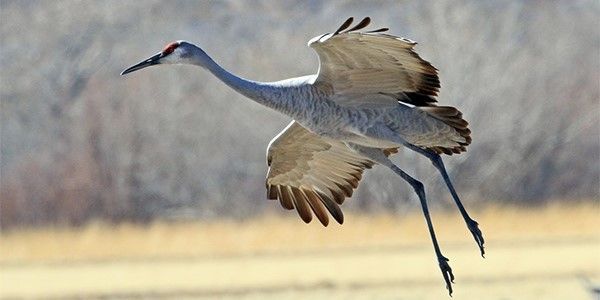Tuleyome's Science Corner - Sandhill Cranes

Sandhill Crane by Bob Zeller, National Wildlife Federation
When is the last time you saw a real-live dinosaur? I’m guessing it’s been a while, am I right? If you’d like to get an up close and personal look at a living fossil, look no farther than the wetlands and surrounding habitat types of California’s Central Valley. Sandhill Cranes (Antigone canadensis) are among the oldest living bird species on Earth. Beginning in October, their arrival from their northern breeding grounds creates quite a spectacle as thousands upon thousands of these giant birds arrive in the Central Valley to spend the winter. Their homecoming is announced by their unique and thunderous bugling calls.
There are 15 species of cranes world-wide with only two species occurring in the United States; Sandhill Cranes and Whooping Cranes. There are three migrating subpopulations of Sandhill Cranes: Lesser, Greater and Canadian, and three non-migratory subpopulations: Mississippi, Florida and Cuban, each occurring in their namesake locations. Both the Mississippi and Cuban subpopulations are critically endangered. Of the three migrating subpopulations, it is the Greater subpopulation that winters here in our region. During the cranes’ migration back to their breeding grounds in the spring, tens of thousands of them congregate along the Platte River in Nebraska. It is there that a fossil from a Sandhill Crane relative estimated to be approximately ten million (!) years old was found.
This living fossil belongs to the taxonomic order Gruiformes which dates back to shortly after the end of the dinosaurs, about 60 million years ago. The oldest conclusive Sandhill Crane fossil dates back about two and a half million years while most modern-day birds’ lineage dates back to less than two million years ago, proving Sandhill Cranes to be much older than most bird species.
Sandhill Cranes are large bulky birds with wingspans from five to seven feet. They stand about five feet tall and can weigh up to twelve pounds. Adults boast mainly slate gray plumage that may be streaked with mud, long necks with pale cheeks, an unmistakable bright crimson cap and their illustrious “bustle” of longer feathers covering their rears. Juveniles have the same gray plumage minus the red cap with the addition of a rusty wash on their on their wings, neck, back and tops of their heads. They are impressive fliers and take advantage of thermals and currents, staying aloft for hours without exerting unnecessary energy. They generally cover up to 300 miles in a single day but some have gone as far as 500 miles with a helpful tailwind. They fly with their necks outstretched and their feet and legs trailing behind them filling the skies with their shape and trumpeting sounds.
Sandhill Cranes are social and live in pairs or with their family groups, but when it is time to make the journey to their wintering grounds, large groups of unrelated cranes come together to migrate, forage and roost as one extensive unit. They mate for life and use their calls along with their elaborate and graceful dance moves to court and secure their life partners. Once bonded, the pairs build grand, mounded nests made of sedges, reeds and grasses in wetlands or the surrounding uplands. One to three eggs are laid and will hatch about a month later. As is common with ground-nesting birds, the hatchlings begin wandering from the nest after only a few hours. The young begin to fly at about three months of age, but remain with the parents during migration and for the remainder of the year until the next clutch is laid the following season. They are omnivores and their diet changes with their locations and the seasons. While in California they forage for seeds, plants, worms, snails, reptiles, amphibians, and small mammals in open grasslands, fields and wetlands. Sandhill Cranes are famous for their rolling, reverberating calls which are a result of their anatomy. Their trachea is very long and coils into their breast bone which lowers the pitch and amplifies the sound of their call which can be heard for long distances.
They’re only here for a short time and if you’d like to see how special they are just visit the Woodbridge Ecological Reserve and/or the Cosumnes River Preserve from October through February. Cosumnes River Preserve offers guided Sandhill Crane tours. Note, you will need a Lands Pass, or a hunting or fishing license to enter the Woodbridge Ecological Reserve. And, although they’re enormous, you’ll kick yourself if you forget your binoculars!
-Kristie Ehrhardt (kehrhardt@tuleyome.org)
Tuleyome Land Conservation Program Manager
RECENT ARTICLES






